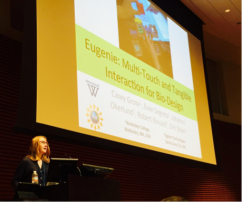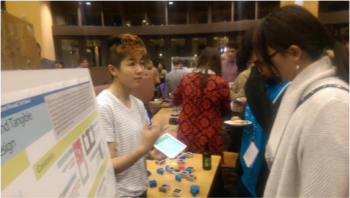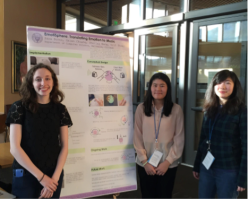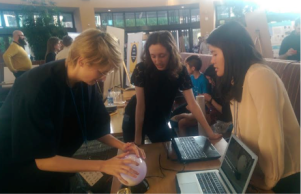A few weeks ago, we traveled to Stanford, CA for the TEI (Tangible, Embedded and Embodied Interaction) Conference. We had a blast – aside from enjoying the beautiful and warm California weather, we were 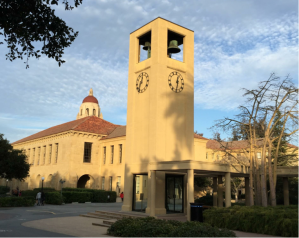 introduced to a variety of interesting projects and frameworks through the paper talks and demo sessions. Stanford’s campus was definitely one to marvel at, with the red roofs and sandstone colored walls.
introduced to a variety of interesting projects and frameworks through the paper talks and demo sessions. Stanford’s campus was definitely one to marvel at, with the red roofs and sandstone colored walls.
The conference opened with a keynote by Frank Wilson, who spoke about the history of the human hand and its relevance to the world of tangible and interactive technologies. The human hand is important, not only from a functional standpoint, but also personally. We use our hands from the moment we are born to start exploring and discovering the nature of the physical world. Our hands are arguably the most direct way to interact with and understand physical objects in front of us. The way young children use their hands to touch, poke, rub, hit, and trace objects is insightful to the nature of all our interactions with the physical world. This also makes our hands an important part of our identity. It is inspiring as an interaction designer to think about our relationship with our hands, but also an important research question to think about how to design for people who don’t have hands.
During the conference, we also demoed and presented our own project, Eugenie (shown below), a system that combines tangible active tokens with a multitouch surface to support biologists in a process for bio-design that involves forming complex queries and exploring a large dataset. Users build rules with the physical tokens and then stamp the rules to the surface, where they can explore and interpret the results. The goal of the system was to explore how tangible interaction can be applied to collaborative experiences for dataset exploration. Many people were interested during the demo session in the block-like structure of the pieces and even some children were compelled to explore the pieces themselves.
We also had three students from our TUI Fall 2014 class present their final project, the Emotisphere (shown below), during the TEI poster session. Using an Arduino, galvanic skin sensors, and a heart-rate monitor, this project connects emotion and music. The sensor information is interpreted as an emotion and generated into a song. The sphere itself can be manipulated in different ways (shaking, twisting, rolling) to control various aspects of the music (volume, changing songs, etc.). The attendees seemed to enjoy learning about and playing with the Emotisphere.
It was empowering to come to the conference with our own research to present, but it was also humbling to be among so many amazing people and hear about their interesting research. The rest of the conference was packed with paper talks and demo sessions. The presentations covered everything from analysis frameworks to the latest projects incorporating new forms of interaction. A few unique applications included MugShots, which allows for social interaction in the workplace by adding a small display to a mug; PaperFold, which uses thin-film foldable displays to give users a new way to interact with digital “paper;” VoxBox, a tangible machine that helps solicit feedback from event participants; DisplaySkin, which offers a novel approach to wrist wearables by utilizing pose-aware displays; and SPATA, a spatio-tangible measurement tool that connects virtual design environments with the physical world.
One of the most interesting demos was a toy remote control car that was controlled by a smaller to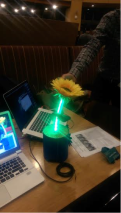 y remote control car. You would drive the smaller one around and the larger one would drive in the same pattern. It was such a simple idea, but it makes so much sense. Rather than having to mentally translate the desired path of the car to the left-right/ forward-back switches of typical toy car remotes or even having to translate it to the motion of a steering wheel, you could just imagine the path of the car and it would happen. One of our other favorite demos was a light-up flower (pictured on the right) that is connected to sensors in the user’s chair. The idea is that the flower sits casually on the user’s desk and droops and turns red when they have bad posture. It’s a fun and ambient reminder to have good posture.
y remote control car. You would drive the smaller one around and the larger one would drive in the same pattern. It was such a simple idea, but it makes so much sense. Rather than having to mentally translate the desired path of the car to the left-right/ forward-back switches of typical toy car remotes or even having to translate it to the motion of a steering wheel, you could just imagine the path of the car and it would happen. One of our other favorite demos was a light-up flower (pictured on the right) that is connected to sensors in the user’s chair. The idea is that the flower sits casually on the user’s desk and droops and turns red when they have bad posture. It’s a fun and ambient reminder to have good posture.
The conference closed with an inspiring keynote by Wendy Mackay that was all about paper. She started by sharing many of the projects she’s worked on that were systems inspired by paper-based interactions. It’s interesting that the design principle for the most common computer operating systems is a desktop. There are documents and pages that can be layered, neighbored, or put away when not in use. It’s a powerful metaphor and it makes sense- we are used to working with a physical desktop and we would want our digital environment to be familiar to us. However, many people seem to be working towards digital systems that could completely replace the physical desktop with a digital one, and this is probably not the best approach. If this were to happen, we would lose many of the personal and intimate interactions we have with paper. One example of this Wendy mentioned was how composers notate their compositions while they are in the process of composing. Everyone has a slightly different system that makes sense to only them, and also the symbols they develop naturally take on different meanings based on not only where they are written, but how they are written. It is hard to have computer systems that allow for such personal and unique interactions. So based on all these reasons, Wendy suggests that rather than creating digital environments to replace the physical ones we have always known, perhaps we should rather strive to introduce computation to the physical environments to enhance them and enrich the interactions. Rather than trying to replace the physical world, we should be celebrating it and leveraging our established interactions with it.
Overall, we had a wonderful time at TEI sharing our projects from the HCI Lab and learning about the research practices and projects in the world of tangible, embedded, and embodied interaction. We were inspired by the work and conversations we had with many brilliant computer scientists, artists, and philosophers. The energy from the conference was contagious and we are excited to continue our work in the lab, incorporating some of the energy and inspiration from the conference.
